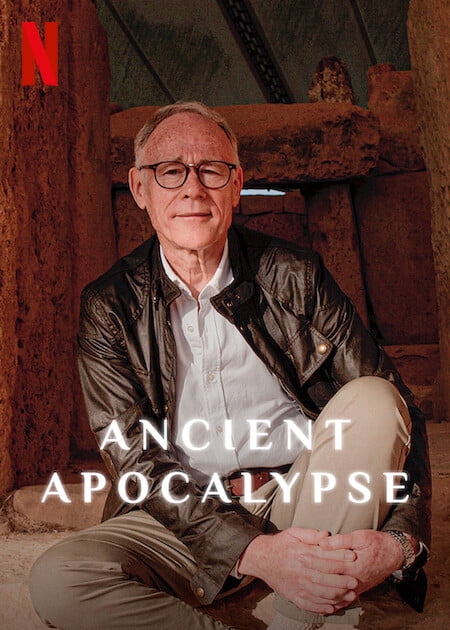
Ancient Apocalypse is a 2022, 8-episode docuseries available on Netflix, created and presented by Graham Hancock, and this article serves as an Ancient apocalypse Review.
Before we dive straight into a review of the series, I think it is best to look at the man behind the series just for some context so…
Who is Graham Hancock?
Graham Hancock is a journalist and a multi-international bestseller author. Born in Edinburgh on the 2nd of August 1950, Graham spent many of his early years in India, where his father worked as a surgeon. He later returned to the UK, was educated in Durham, and graduated from Durham University with First-class honours in sociology in 1973.
He pursued a career in journalism, writing for many of Britain’s leading newspapers, including The Times, The Sunday Times, The Independent, and The Guardian. His writing moved in the direction of books in the early 1980s, which focused on his experiences through travelling and the socio-economic situations he had observed in Africa.
Hancock’s big breakthrough came in the early 1990s with the publication of The Sign and The Seal, which details his incredible investigation into the location of the lost Ark of the Covenant. He later created Fingerprints of the Gods in 1995, followed by the sequel Magicians of the gods (2015). These works have been his most controversial and attacked due to his discussions of what is likely to be the true ancient world when looking at highly intelligent human life originating a long time before the academic world likes to place its bets.
Hancock has been ridiculed on multiple platforms by academics for his views surrounding the history of the human species and world events such as the Younger Dryas impact hypothesis, a cataclysmic event created by a series of impacts from comet debris that initiated the Younger Dryas event some 12,900 years ago causing global flooding and sea levels to rise 120m (400ft). This event is the possible cause of the extinction of many species in North America, such as the Columbian mammoth, the Dire wolf, the Camelops, and megafauna. Hancock also attributes this event as the reason for a lost time in history when intelligent human civilizations lived and thrived culturally in a time well before, even up to 18,000 years before academics believed intelligent, civilised life existed.
Hancock is regularly labelled a Pseudoarchaeologist, even on his own Wikipedia page, referencing him as someone whose works are “quotes are presented out of context, critical countervailing data is withheld, the state of understanding is misrepresented, or critical archaeological information about context is ignored”.
This ridicule and frankly abusive behaviour from the academic community, especially archaeologists, comes from Hancock simply asking where we came from. And even more to the point, when do we come from? With overwhelming evidence that the experts may have got it wrong, Hancock leads the way among many others who believe there is more to the history of civilised human life as we are taught and told by the current leaders in the field of human history. A term he is now coining as Human Pre-history.
Ancient Apocalypse what to expect.
With the support of multiple historians, marine biologists, theologists, amateur geologists, and more, Graham travels across continents searching for clues of a lost civilisation and evidence of the Younger Dryas’ impact both physically and within ancient texts.
Hancock’s opening gambit is that humans are a species suffering from amnesia. We have forgotten something incredibly important from our past, a lost civilisation from the ice age, a notion that seems impossible to the “so-called experts” who believe that the science indicated that the ice age was inhabited only by basic hunter-gathers when it comes to the human population.
Ancient Apocalypse Episode 1 – Once there was a flood
In episode one, Hancock takes us to the Indonesian island of Java, which hosts Gunung Padang, an archaeological site that possibly dates way back to the last Ice age, if proven true, would wipe out the common theory that advanced human civilisation didn’t exist until 4000 B.C.
The Name Gunung Padang in the local dialect means Mountian of Enlightenment and is visited far and wide by individuals looking to absorb the mystical powers of this mountain and cleanse themselves in the ancient spring. The site has been a religious point of interest throughout history and long presumed to be just a mountain by the scientific community for a long time.
However, on the summit, Hancock presents the visual of the mountain covered in long hexagonal blocks of stone covering the area, with multiple organised structures in several locations. These rocks are made of basalt and result from volcanic eruptions leading to a quick cooling of the rocks, which crack and form these peculiar shapes.
Dr Ali Akbar joins Hancock, who first started investigating the site in 2012. He explains that he found three specific and peculiar discoveries
- The hexagonal rocks were not originally located in this region and were transported from another location.
- The site has two cultural layers, a cultural layer is a layer of matter deep in the ground that contains evidence of human existence. The first cultural layer dates back to 500 B.C.
- The Second cultural layer dates back to 5200 B.C.
Dr. Danny Hilman Natawidjaja is next to join Hancock to explain some further discoveries that have been made about the mysterious mountain of enlightenment. Dr Hilman is a geologist, and he discovered that the site consists of structured walls and terraces, 5 in total, creating a structure that is approximately 490 feet long and 130ft wide. The site can be best described as a step pyramid built on top of an already 300ft high hill.
Hancock explains that this evidence of the structure and the cultural layer found would blow our knowledge of ancient civilisation out of the water, especially when it comes to the building of pyramid-like structures. This is because currently, our assumption is that the oldest pyramid structure created by man is located in Peru and dates back 4700 years ago, named the Sacred city of Caral-Supe. If the structure of Gunung Pagand is to be accepted as a pyramid and the second cultural layer to be accepted as a date when humans built this structure, that would mean that the structure could be dated well before Caral-Supe, in fact, over 2500 years before.
The plot thickens further as Dr Hilman explains that using Geological technology such as ground penetrating radar, he has unearthed signs of three chambers built inside the megalithic structure, even more evidence broadening the sense that this must have been a man-made structure constructed by an intelligent and sophisticated civilisation. He later explains that using core drilling techniques may suggest that construction of the site began more than 20,000 years ago.
Many criticise these findings citing evidence that the only recorded findings of human involvement in this area are of hunter-gatherers around 9500 years ago.
”In the Pawon cave in Padalarang [about 45 kilometres from Gunung Padang], we found some human bones and tools made of bones about 9500 years ago, or about 7000 BCE. So, if at 7000 BCE our technology was only producing tools of bones, how can people from 20,000 BCE obtain the technology to build a pyramid?”
An undisclosed source as found in https://www.smh.com.au/world/digging-for-the-truth-at-controversial-megalithic-site-20130726-2qphb.html
On numerous occasions, Hancock parries this view with an idea of what if advanced civilisations and Hunter-Gatherers lived simultaneously. Still, they were separated by the difference in culture.
Hancock steers the episode to discuss the changing landscape of the Indonesian area throughout the ice age. He explains that at the time of the Ice age, the Java sea was once a large land mass connected to mainland Asia known as Sundaland.
He points out that even today, advanced technological societies live alongside Hunter-gatherers, such as the San in Namibia.
He finishes the episode by pointing to the fact that he had seen structures made out of the same stone in Micronesia in Nan Madol, Pohnpei. This structure dates back to around 900 years ago. However, Hancock states that he has dived locally to this area and is convinced that he has found evidence of megalithic structures buried under the ocean that would have been visible during the last ice age. Then he explains the events that ended the last Ice age that started with a sudden drop in global temperature followed by a series of earth-altering floods.
His next episode is a visit to Mexico, where the journalist inspects the world’s largest pyramid for signs of a forgotten past.
Ancient Apocalypse Review
Well, if the above synopsis of the first episode tickles your fancy, then it is definitely worth a watch Graham Hancock explores Megalithic sites in Malta, North America Turkey, including Göbekli Tepe and Derinkuyu, an ancient underground city. Bimini rock formation off the coast of Miami was once fabled to be the road to Atlantis.
He offers a great insight into the religious stories of the world, especially ones of great floods and snakes falling from the skies in line with his belief in the Younger Dryas impact hypothesis changing the footprint of the earth as well as potentially wiping out a now lost and forgotten civilisation.
Personally, I thoroughly enjoyed the series, giving an alternative look at history and the possibility of a lost intelligent human refused to be acknowledged by mainstream academia. Of course, there is a lacking of hard-hitting evidence, but before there is any evidence, there is always a theory and a theory that may well make sense if worth investigating.
After watching this, it makes me hungry for more, but that will only come if more research and funding are pumped into a scientific community willing to work on these topics. Looking forward to seeing more from Hancock.
Is there a lost history, well know one thing for sure even with what we do have available in our current history, we still don’t know all the answers for exactly why and when? Maybe the further back we go, the more answers we will get.
References
Wikipedia. 2022. “Graham Hancock.” Wikimedia Foundation. Last modified November 14, 2022. https://en.wikipedia.org/wiki/Graham_Hancock
Graham Hancock Biography https://grahamhancock.com/bio/
The Sydney Morning Herald “Digging for the truth at controversial megalithic site”. July 27, 2013, https://www.smh.com.au/world/digging-for-the-truth-at-controversial-megalithic-site-20130726-2qphb.html




